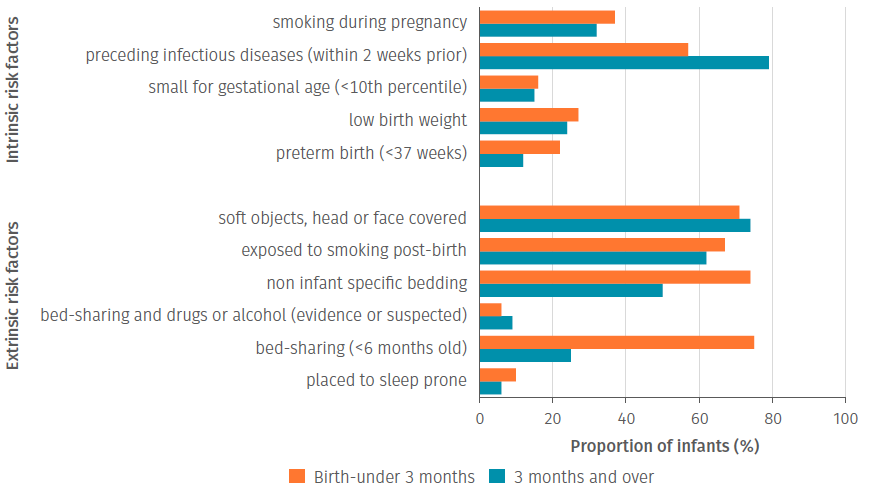
Deaths of children in NSW in 2016 and 2017: Sudden Unexpected Death in Infancy (SUDI)
SUDI is not a cause of death. Infant deaths are classified as SUDI when a cause of death is not immediately apparent at the time of death. It excludes infants who die unexpectedly due to injury – for example in a motor vehicle crash – and deaths that occur in the course of a known acute illness in a previously healthy infant.
In NSW in 2016 and 2017, the deaths of 83 infants aged less than 12 months were classified as SUDI, including 35 infants in 2016 and 48 infants in 2017, representing an infant mortality rate of 0.4 and 0.5 deaths per 1,000 live births respectively. Investigations have been completed for 61 infants: 23 died due to natural causes, 14 from unintentional asphyxiation, and for 24 infants, no cause could be determined.
Trends in SUDI
Despite some yearly fluctuations, trends over the past 15 years show that while the rate of SUDI has declined, this decline has plateaued and the rate has not changed significantly over the past decade (since 2008). In addition:
- Most infants who die suddenly and unexpectedly are very young. Over two thirds of the infants whose deaths were classified as SUDI over the past 15 years were less than three months of age.
- Aboriginal and Torres Strait Islander children were over-represented in SUDI, accounting for almost 20% of the deaths.
- SUDI disproportionately affects vulnerable families and infants living in disadvantaged areas. The infant mortality rate for SUDI is nearly seven times higher for infants living in areas with the highest levels of socio-economic disadvantage than for those living in the least disadvantaged areas. Infant mortality rates are also lower in cities compared to regional and remote areas.
- Almost half the infants whose deaths were classified as SUDI were from families known to child protection services.
For many infants who die suddenly and unexpectedly, a cause of death is never identified. Identifying a cause is important for many reasons, including understanding how to prevent deaths.
Where cause of death is determined (explained SUDI), most are due to natural causes – generally an underlying illness or condition that was not identified or recognised as life threatening before death. Other determined causes of death are generally due to accidental asphyxiation, primarily associated with an unsafe sleeping environment.
Risk factors associated with SUDI
Some risk factors associated with SUDI are intrinsic to the infant and cannot be changed – for example premature birth (< 37 weeks gestation), and low birth weight (< 2500g). However many risk factors associated with SUDI are avoidable, and can be changed or modified, such as exposing an infant to tobacco smoke.
In 2016 and 2017, the majority (71 of 83) of infants who died suddenly and unexpectedly were exposed to at least one avoidable risk. In many instances, a number of risk factors were identified. The three most frequently identified modifiable risks were:
- Exposure to tobacco smoke (two-thirds of the infants)
- Bedding not designed for infants – nearly two-thirds of the infants were sharing a sleep surface – adult beds or mattresses, sofas, and other surfaces
- Placed in a sleep environment with loose bedding or other soft objects that posed a suffocation risk.
Figure 1: Key reported risk factors identified for SUDI by age group, 2016-17

Key observations
- The rate of SUDI is not declining. A disproportionate number of SUDI occur in vulnerable families and/or those living in disadvantaged areas. Agencies need to focus prevention initiatives on targeting interventions to infants in these families.
- Many of the risks to which infants were exposed are avoidable, including smoking and bedding not designed for infants. There is a need for multi-faceted preventative approaches, and for interventions to be ‘relatable’ to the target groups.
- Early recognition of illness in infants is an important prevention strategy. A preceding infectious illness was present for more than half the infants who died suddenly and unexpectedly, and for some infants, undiagnosed illness was fatal.
This page contains key information from the Biennial Report of the deaths of children in New South Wales: 2016 and 2017.
Contact us for more information
Our business hours are: Monday to Friday, 9am–5pm (Inquiries section closes at 4pm)
If you wish to visit us, we prefer you make an appointment. Please call us first to ensure your complaint is within our jurisdiction and our staff are available to see you.
NSW Child Death Review Team
NSW Ombudsman
Level 24, 580 George Street
Sydney NSW 2000
Email cdrt@ombo.nsw.gov.au
General inquiries 02 9286 1000
Toll free (outside Sydney metro) 1800 451 524
National Relay Service 133 677
Telephone Interpreter Service (TIS): 131 450
We can arrange an interpreter through TIS or you can contact TIS yourself before speaking to us.
© State of New South Wales, June 2019
This publication is released under a Creative Commons license CC BY 4.0.
Publication metadata
| ISBN | 978-1-925885-10-1 |
|---|---|
| Category | Fact sheets |
| Publication Date | 25 June 2019 |
